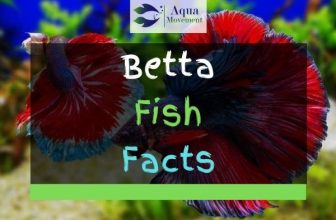How to Lower Nitrite Levels in Freshwater Aquarium
Nitrites naturally occur in your aquarium, but you and your fish definitely don’t want them.
However, they play an essential role in your tank, so you should understand why they happen and how to lower nitrite levels in freshwater aquarium.
Nitrites are invisible but they have a huge negative impact on the health of your fish in an aquarium.
In this article, you’ll learn how to detect nitrites and how to lower nitrite levels in freshwater aquarium.
Whether you’re a beginner or have been keeping fish for a while, this article will help you keep your fish healthy.
Table of Contents
What are Nitrites?
Nitrite poisoning is a serious issue that you should avoid if you want to keep your fish healthy in an aquarium.
However, before getting rid of nitrites, you should understand why they’re present in the tank.
Video: “Nitrite and Nitrate in the Aquarium”
Fish excrete ammonia through their gills and in their waste. Moreover, rotten food particles and dead plants break to form ammonia which later transforms into nitrites.
Dirty filters can also cause nitrites to accumulate in your tank because the filter isn’t doing its job and getting rid of ammonia promptly.
Nitrites accumulate due to the nitrogen cycle or nitrification. This is how it happens in a tank.
- Natural waste breaks down in the tank, producing ammonia or NH3.
- A special type of bacteria called Nitrosomonas starts to break the ammonia and transforms it into nitrites.
- After that, the Nitrobacter bacteria convert the nitrites into nitrates after feeding on them.
This is a natural process that happens because the fish naturally excrete waste when they breathe and eat.
Both ammonia and nitrites are highly toxic to the fish in your tank.
Can Nitrites Cause Poisoning in Nature?
In their natural habitat, the volume of water per fish is extremely high. This means that regardless of the levels of nitrites in a lake or a river, they’ll get diluted so fish will stay healthy.
However, in a water tank, the levels of nitrites can increase significantly in a few hours causing fish poisoning.
Unlike nitrites, nitrates are non-toxic to fish. However, if you have an unhealthy tank, there will be a significant amount of ammonia and nitrites; enough to make your fish sick and might cause several members to die.
What Levels of Nitrites are Acceptable in Your Freshwater Tank?
None.
The slightest increase in the levels of nitrites or ammonia means that your fish are in extreme danger.
You should act promptly to clean the water and take care of the sick fish before members start to die out.
Your only hope is to make sure that there’s a way to get rid of all the nitrites or to convert these compounds into nitrates which won’t harm your fish.
The bacteria that change ammonia to nitrites are found in the air.
As soon as you have an ammonia source in your aquarium, the bacteria will be tempted to live and establish a colony in your tank to feed on the ammonia.
What Causes an Increase in the Levels of Nitrites?
There are several reasons why nitrites can increase in your aquarium.
- You’re setting up a new tank. The bacteria necessary to change the nitrites to nitrates might still need time to multiply so they can do their job right. This means that the biological filter in the tank isn’t working properly.
- You’re overfeeding the fish. You should always provide your fish with enough food that they can finish in a minute or two. All the excess food will be discarded and will collect at the bottom leading up to the increase in the levels of ammonia and nitrites in your tank.
- Your tank is overpopulated. This means that the volume of water per fish is low. Fish produce waste when they breathe and eat through poop and pee. An overpopulated tank means that the water won’t be able to dilute the nitrites in your aquarium.
- You don’t clean the tank often. If you’re keeping plants in your tank, they naturally die and decay. You should remove the dead plants promptly because the decayed plants will decompose and change to ammonia and then nitrites.
- A sudden change in the chemistry of water will reduce the number of bacteria which transforms nitrites to nitrates. If you suddenly change a big portion of the water, you might be accidentally decreasing the number of bacteria and destroying the biological filter in your water.
What Are the Symptoms of the Increase in Nitrites?

Taking a look at the fish in your tank can help you determine if there’s a problem with the water.
Here are some signs that the nitrite levels have increased in your aquarium.
- Your fish are gasping for air at the top of the tank.
- The gills of your fish look reddish, purple or brown.
- Fish are trying to hang next to water outlets.
- Some of the fish are lying at the bottom of the tank.
- The gills of your fish are moving too fast.
- You can see lots of dead fish.
If you see some or all of these symptoms, then your fish are suffering from nitrite poisoning.
This is also known as brown blood disease, as the fish blood turns brown due to the increase of methemoglobin.
As the level of methemoglobin increases in the blood, it becomes unable to carry oxygen, causing the fish to suffocate and die. This is why fish will be gasping for air.
Some species of fish are hardy and can withstand some nitrites. But continuous exposure to even the lowest levels of nitrites affects the immune system and causes damage to the liver and blood cells.
As a result, fish will be prone to other secondary diseases that affect the whole population in the tank.
Some fish won’t show any signs of illness. They will die all of a sudden without prior warning. You should keep an eye on the tank to keep track of any sudden changes.
How to Detect a Change in the Levels of Nitrites?
[amazon box=”B000255NCI”]
An aquarium water test kit should be used to test the levels of nitrites in your water periodically.
There are several easy-to-use kits that can help you detect the slightest change in the chemistry of the water in your aquarium. Here are some of their benefits.
- A good kit will help you detect the slightest change in the levels of ammonia. This will help you treat the problem before it manifests.
- The kit can detect an increase in phosphates which creates the perfect environment for green algae to grow. The water in the tank will be green and unclear, causing the fish to be distressed.
- If you’re using tap water, you should use a kit to make sure that there’s no chlorine in your tank. Using a de-chlorinator is essential because high levels of chlorine will cause your fish to act irritably.
- In reef aquariums, you should make sure that the calcium levels are under control. Calcium is essential for the growth of reefs but your fish need it among other nutrients to stay healthy. A kit will help you maintain the calcium levels within the normal range.
- Whether you have a fresh or saltwater tank, you should make sure that the pH level is suitable for the species you’re growing. A kit detects the slightest change in the pH level to keep your fish healthy.
Check Price and Reviews on Amazon
Video: “How To Test Your Aquarium Water”
How to lower Nitrite Levels in Freshwater Aquarium?
If you’ve already detected an increase in the levels of ammonia or nitrites, then you should act promptly.
This might be due to the excessive production of ammonia or the inability of the bacteria to transform nitrites or nitrates. Here’s what you should do.
- Do partial water changes.
- Remove all the organic materials before they start to rot to reduce the levels of ammonia in your tank.
- Using an aquarium water conditioner will change the nature of these harmful chemicals in the tank. Some of these conditioners can turn ammonia to ammonium which is not poisonous to the fish. Some of them can also reduce the levels of nitrites in the water.
- Feed the fish reasonably. You can start by providing the fish with enough food to finish within 30 seconds. Increase the amount of food so that fish can eat for a minute or two, but not more because the excess food particles will accumulate to make your tank unhealthy.
- Stop feeding the fish if necessary. The less food you give to your fish, the less waste they will produce, which will decrease the levels of ammonia in the tank. Don’t worry because the fish won’t starve if they don’t eat for a few days until all ammonia and nitrites have converted to nitrates.
- Increase the volume per fish in the tank by moving your fish into a bigger tank. You can also reduce the number of fish by moving some of them to another tank.
- Install an aquarium heater to increase the temperature in the tank. This will promote the growth of the good bacteria that prefer warmer water and more oxygen to multiply.
- Think about adding aquarium salt to your tank. This is made of evaporated seawater and contains no additives. A little salt will be able to keep the osmotic pressure under control. If you have a new tank or have changed the water recently, the salt will prevent possible nitrite poisoning.
- Add more bacteria to your tank. There are several products that will introduce live bacteria to help restore the balance to your aquarium.
Why and How Should You Change the Water in your Aquarium?
Partial changes are essential to keep the levels of nitrites under control. This method has several benefits.
- Changing about 20% of the water will dilute the nitrites.
- It reduces the percentage of other dissolved toxins that can affect the health of your fish.
- It helps get rid of the debris in the water.
- It lengthens the life of your water filter.
- It keeps the water clear so you can watch your fish.
However, you should be careful while changing the water in the tank because the wrong procedure can actually harm your fish.
- Total water changes can shock the fish.
- Changing more than 20% of the water per week will affect the colonies of bacteria in the tank. These are essential to transform toxic ammonia and nitrites into nitrates.
- If you choose to increase the volume of water, don’t add new members to the aquarium. This will cause the levels of nitrites to increase.
Using a Gravel Cleaner in Your Tank to Lower the Levels of Nitrites
In addition to the usual weekly partial water change, you’ll need a gravel cleaner to reduce the levels of ammonia in your aquarium.
Here are some of the pros of a gravel cleaner.
- This is a vacuum cleaner that will remove all the dead plants, rotten food, and dead fish from the bottom of the tank.
- It will keep the water clean so your water looks clear.
- A good gravel cleaner will allow you to change the water less frequently while keeping your fish healthy.
There are two types of gravel cleaners. One of them siphons off dirty water and replaces it with clean water. While doing so, it will also get rid of all the waste in the water.
The other type doesn’t remove the water, but will only trap the uneaten food and waste to keep the water clean.
However, you should be careful while using a gravel cleaner as you might accidentally suck out a small fish.
6 Best Aquarium Vacuum Cleaner for Gravel & Sand
Summary
The lowest levels of nitrites in your tank will cause stress that makes your fish unhealthy. In order to maintain a healthy aquarium, you should keep the ammonia and nitrites level to zero.
Regular testing of the water and knowing how to lower nitrite levels in freshwater aquarium will help keep your fish healthy.
If the level of nitrites is still high, you might need to install a new filter or move your fish into a new tank.




